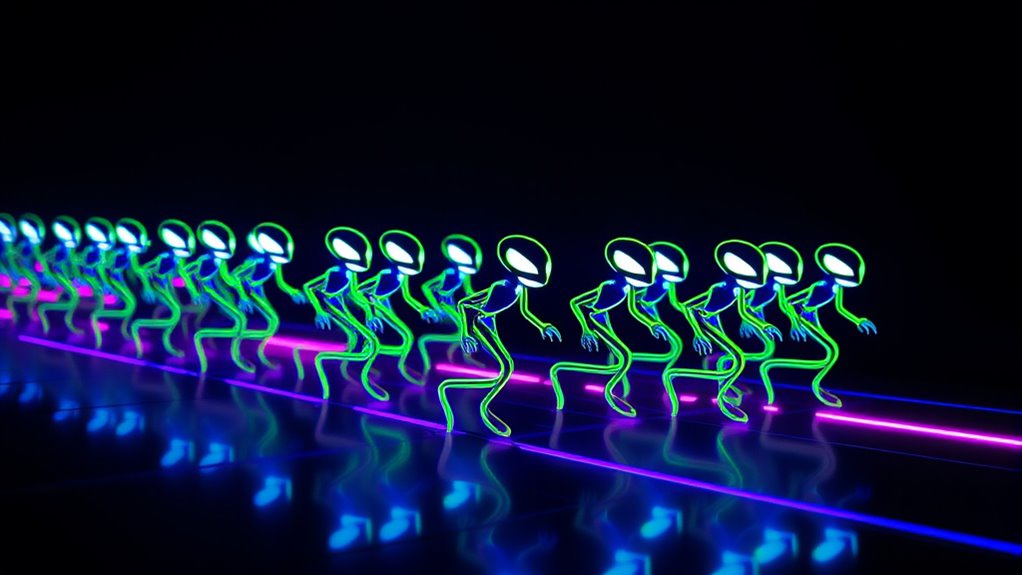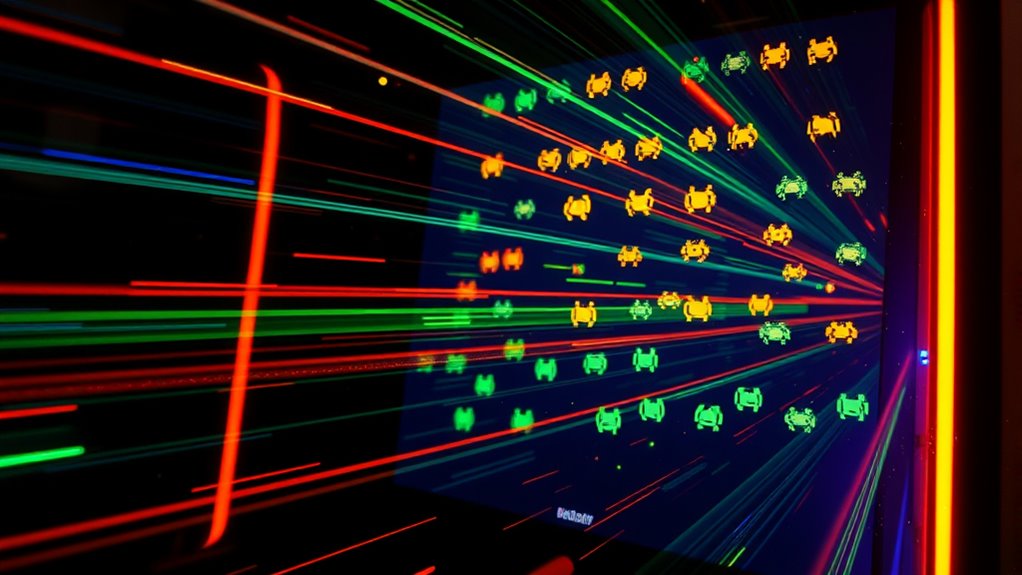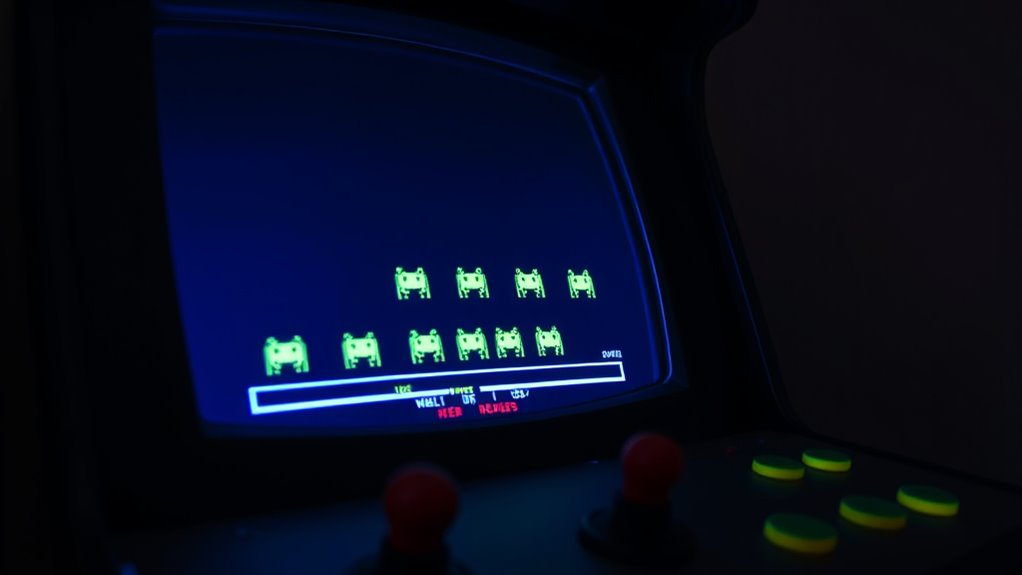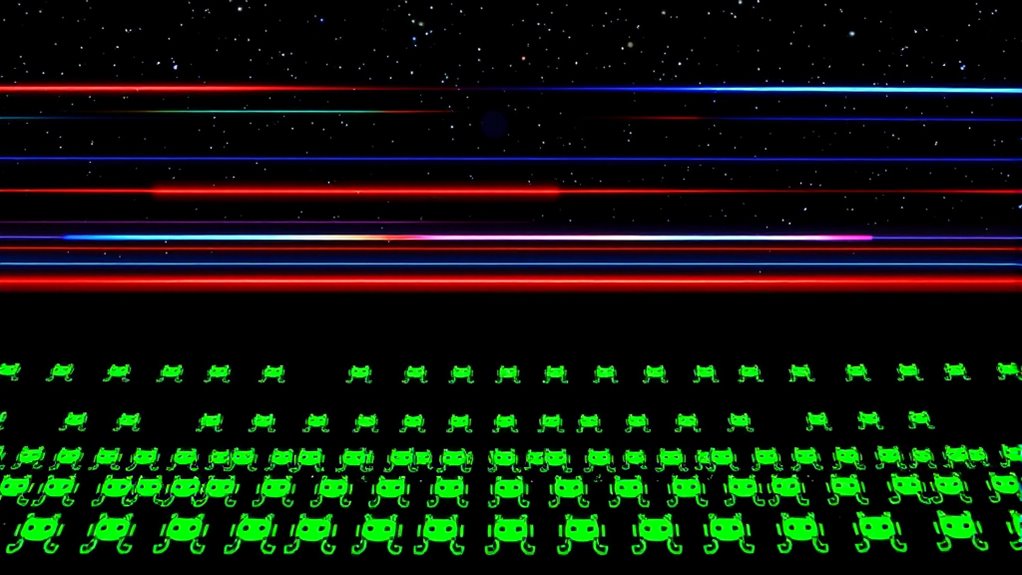In Space Invaders, tempo and music play vital roles in building tension as alien waves advance. The game’s simple electronic sounds synchronize with enemy movements, increasing urgency and excitement. Faster beat patterns boost adrenaline, making you react quicker. The minimalist soundtrack creates a sense of alien invasion and suspense. If you keep exploring, you’ll discover how this innovative sound design shaped gaming history and continues to influence game audio today.
Key Takeaways
- The game’s tempo accelerates as aliens descend, increasing tension and player urgency to respond quickly.
- Music cues synchronize with alien movements, enhancing gameplay intensity and guiding player reactions.
- The minimalist electronic soundtrack features procedural melodies that change with each wave, heightening suspense.
- Alien advances are often timed with musical cues, creating rhythmic harmony that amplifies the sense of invasion.
- Faster tempos and rhythmic patterns in the sound design boost excitement, influencing player reflexes and strategic gameplay.
The Origins of “Space Invaders” and Its Cultural Impact
“Space Invaders” revolutionized the gaming industry when it was released in 1978, marking one of the first successful arcade shooters. Its alien design instantly became iconic, with simple yet menacing shapes that players could easily recognize. The game graphics, though primitive by today’s standards, were groundbreaking at the time, using crisp black-and-white visuals to create a sense of depth and urgency. You can see how the alien shapes, arranged in rows, evoke an invading force, fueling the game’s tension. The combination of distinct alien designs and straightforward graphics made the game accessible and addictive. Its visual style influenced countless future titles and helped establish the visual language of early arcade games, leaving a lasting cultural imprint.
The Role of Tempo in Creating Tension and Excitement

Have you ever noticed how the pace of a game can make your heart race or calm your nerves? Tempo plays a essential role in building tension and excitement, heightening your immersion. Faster tempos increase the urgency, making you feel more involved. Consider how:
Tempo shapes your gaming experience, intensifying excitement and immersion with every beat.
- The quickening rhythm heightens adrenaline during alien assaults
- Slower phases provide brief relief, creating contrast
- Ambient noise subtly shifts with tempo, reinforcing the mood
- The use of musical elements like tempo variation can manipulate emotional responses and elevate gameplay intensity
This dynamic variation keeps you on edge, amplifying player immersion as you anticipate the next wave. The tempo’s shifting pace mimics the alien invasion’s unpredictability, making each encounter more intense. By controlling tempo, the game taps directly into your emotional response, making every moment feel essential and alive.
Analyzing the Game’s Electronic Soundtrack and Its Effects

The electronic soundtrack of Space Invaders uses innovative chiptune techniques that give the game its distinctive sound. These audio choices directly influence how players experience gameplay, heightening tension and immersion. Understanding how the music is crafted reveals its powerful effect on the overall gaming experience. Additionally, the incorporation of sound design principles enhances the emotional connection players develop with the game.
Chiptune Composition Techniques
Analyzing the electronic soundtrack of Space Invaders reveals how chiptune composition techniques create an immersive gaming experience. You notice how the music relies on:
- A procedural melody that varies slightly with each wave, heightening tension.
- A synthesized bass that provides a steady, pulsating rhythm, mimicking the alien threat’s advance.
- Simple, repetitive patterns that loop seamlessly, reinforcing the game’s urgency.
- The use of sulfate-free sound elements helps maintain the clarity and sharpness of the audio, preventing auditory fatigue during extended play sessions.
These techniques allow the sound to evoke emotion without complex layering. The procedural melody keeps players engaged through variation, while the synthesized bass maintains a consistent sense of movement. Together, they produce a compelling atmosphere that enhances gameplay intensity and immerses you in the impending alien invasion.
Audio Impact on Gameplay
How does the electronic soundtrack of Space Invaders shape your gaming experience? The ambient noise created by its simple, repetitive beeps heightens your sense of urgency, making each alien movement feel more immediate. This minimalist sound design keeps you alert without overwhelming your focus, blending seamlessly into the gameplay. The soundtrack’s steady tempo reinforces the relentless advance of the invading aliens, enhancing your player immersion. As you dodge shots and fire back, the electronic sounds serve as an ever-present reminder of the game’s tension, fueling your adrenaline. Instead of distracting, the ambient noise becomes an integral part of the environment, immersing you deeper into the arcade universe. This careful audio design amplifies the game’s intensity and keeps you engaged from start to finish. Additionally, the audio impact of the soundtrack reflects the game’s era, emphasizing its status as an iconic classic.
How Music Influences Player Reaction and Strategy

Music in Space Invaders markedly shapes how players react and develop strategies. It heightens player immersion and triggers emotional responses that influence gameplay. For example:
Music in Space Invaders profoundly influences player reactions and strategic choices, enhancing immersion and emotional engagement.
- Fast-paced music energizes you, prompting quicker reflexes and aggressive tactics.
- Dramatic tones evoke tension, making you more cautious and strategic with your shots.
- Steady rhythms help you anticipate alien movements, sharpening your focus and timing. These musical cues guide your reactions, subtly steering your approach without conscious effort. Additionally, understanding the psychological impact of music can enhance your gaming experience by further influencing your emotional state. As a result, you become more engaged, and your emotional response intensifies, affecting decision-making. The music’s influence extends beyond mere background; it becomes an integral part of your gameplay experience, shaping how you perceive threats and opportunities on the screen. This synergy between sound and strategy deepens your overall immersion.
The Synchronization of Alien Movements and Musical Cues

As you focus on the game, you’ll notice that the alien movements often seem to synchronize seamlessly with the musical cues, creating a rhythmic harmony that guides your reactions. The alien movement patterns are timed to the beat of the music, making their advance feel almost musical in nature. When the aliens shift direction or descend, it’s often aligned with a specific musical cue, amplifying the tension and urgency. This synchronization helps you anticipate their actions, as the rhythm provides subconscious clues about upcoming movements. The musical cues act as a tempo guide, shaping your pacing and focus. This tight coupling between alien movement and music not only heightens the game’s intensity but also immerses you in a cohesive, rhythmic experience. Recognizing these patterns can enhance your gameplay by leveraging your understanding of developmental cues and timing.
The Evolution of Sound Design in Arcade Games

The evolution of sound design in arcade games reflects a continuous quest to enhance player engagement and immersion. Early on, developers used simple retro sound effects to signal actions. Over time, the focus shifted to integrating melodic motifs that create memorable themes. You can see this in three key developments:
Sound design in arcade games evolved from simple effects to immersive, melodic, and dynamic audio experiences.
- The shift from basic beeps to richer, layered sounds that add depth.
- The use of melodic motifs to establish mood and identity, like Space Invaders’ iconic alien sounds.
- The incorporation of dynamic audio cues that respond to gameplay, heightening tension and excitement.
- Incorporating audio feedback techniques that respond to player actions further enhances the immersive experience.
These advancements help create a more immersive experience, making players feel connected to the game world through evolving soundscapes. This progression highlights how sound design became essential to arcade game identity and player retention.
The Psychological Impact of Rhythm and Music on Gameplay

Sound design in arcade games has long aimed to heighten player engagement, but rhythm and music do more than just complement visuals—they influence your emotions and reactions in real time. When the beat syncs with enemy movements, it creates emotional resonance, making the game feel more intense. The music also boosts cognitive engagement, helping you anticipate attacks and strategize better. Imagine this:
| Beat | Enemy Movement | Your Reaction |
|---|---|---|
| Fast | Rapid fire | Quick reflexes |
| Slow | Approaching | Cautious stance |
| Sync | Shooting | Focused aim |
| Offbeat | Lurking | Confusion |
| Silence | Resting | Calmness |
This interplay keeps you immersed, heightening both your emotional response and mental involvement. Additionally, AI-driven sound design can dynamically adapt music to match gameplay intensity, further amplifying engagement.
Technical Aspects of Sound Implementation in “Space Invaders”

You’ll see how the game creates sounds using basic synthesis methods, given the limited technology of the time. The hardware constraints mean each tone must be carefully generated to produce recognizable effects. Understanding these technical choices helps explain the distinctive audio that defines “Space Invaders.” Additionally, the game’s sound design reflects the importance of sound effects in enhancing player engagement and immersion.
Sound Synthesis Techniques
To create the iconic sound effects in “Space Invaders,” developers relied on simple yet effective sound synthesis techniques that utilized basic electronic components. These synthesis techniques shaped the game’s distinctive sound design, making it instantly recognizable. You can imagine the process as: 1. Using a square wave generator to produce the laser blasts and alien sounds, providing a sharp, electronic tone. 2. Employing a resistor-capacitor (RC) circuit to create pitch variations, giving depth and variation to the alien movement sounds. 3. Modulating frequency to simulate threat levels, adding a sense of urgency and progression. This straightforward approach allowed the sound effects to be generated with minimal hardware, emphasizing clarity and consistency in sound synthesis for the game’s audio experience, with contrast ratio playing a crucial role in how well these sounds translate across different display environments.
Audio Hardware Limitations
The simplicity of the sound synthesis techniques in “Space Invaders” was driven by the hardware constraints of the arcade’s electronic components. You’re limited by audio hardware limitations that restrict the complexity of sound production. The machine relied on primitive sound synthesis, using basic circuitry to generate audio signals. Instead of sophisticated digital processing, it employed simple oscillators and timers to produce tones. These constraints meant you couldn’t create rich sound effects but had to make do with basic beeps and buzzes. This hardware-driven simplicity shaped the game’s iconic audio cues, which are direct and effective despite their primitive nature. Overall, the limitations forced designers to innovate within strict boundaries, resulting in a distinct, memorable sound aesthetic that’s still recognizable today.
Legacy and Inspiration for Future Game Soundscapes

How did Space Invaders shape the sound design of future video games? It introduced a distinctive approach to alien communication through simple, repetitive cosmic melodies that became iconic. This set a precedent for how game soundscapes can evoke otherworldly atmospheres and tension. Your understanding of its legacy reveals three key influences:
- The use of minimalist sound effects to create a sense of alien presence.
- The integration of rhythmic patterns that heighten gameplay intensity.
- Inspiration for future composers to craft alien communication sounds that are both eerie and memorable.
These elements continue to inspire game designers, pushing the boundaries of sound design. Space Invaders’s legacy proves that even limited technology can generate a lasting impact, shaping the way future games approach cosmic melodies and alien soundscapes.
Frequently Asked Questions
How Did the Game’S Sound Design Influence Later Arcade and Video Games?
You see, the game’s sound design set a precedent for future arcade and video games by pioneering sound effect innovation and embracing chiptune aesthetics. You’re influenced by its simple, catchy sounds that became iconic, inspiring developers to craft memorable audio cues. This approach showed how minimalistic, synthesized sounds could create immersive experiences, shaping the way games use audio to engage players and establish atmosphere in the digital age.
What Specific Musical Techniques Were Used to Build Suspense in “Space Invaders”?
You feel the suspense build as the game uses beat synchronization to create a rhythmic pulse that heightens tension. Melodic tension is carefully crafted through rising tones and dissonant notes, making each alien approach more intense. The music’s gradual acceleration, combined with syncopated beats, keeps you on edge, amplifying the threat of alien invasion. These techniques make every moment more thrilling, pulling you deeper into the game’s relentless excitement.
How Did Hardware Limitations Shape the Game’S Musical and Sound Effects?
You see, hardware constraints in early arcade games like Space Invaders forced developers to get creative with sound synthesis. Limited memory and processing power meant they had to produce sound effects with simple, repetitive tones, shaping the game’s distinctive audio style. These hardware limitations directly influenced the musical and sound effects, resulting in iconic, minimalist sounds that heightened suspense and gameplay intensity while working within technological boundaries.
Are There Modern Games That Directly Reference “Space Invaders”’ Audio Cues?
Imagine a lighthouse guiding ships through fog; some modern games serve as beacons, echoing retro sound motifs from classics like Space Invaders. You’ll find homage games that intentionally incorporate these iconic audio cues, capturing the game’s nostalgic essence. These references act as a bridge, connecting past and present players, reminding you of the game’s pioneering sound design while celebrating its enduring influence in contemporary gaming.
What Is the Psychological Reason Players Respond Strongly to the Game’s Rhythm?
You respond strongly to the game’s rhythm because it taps into your natural rhythm perception, creating a sense of predictability and control. This synchronization triggers an emotional response, making the gameplay more engaging and satisfying. When the beat aligns with your actions, it heightens your focus and excitement, reinforcing positive feelings. Your brain naturally seeks patterns, so rhythmic cues in games influence your emotional state and boost your overall gaming experience.
Conclusion
While some might think music in arcade games like “Space Invaders” is just background noise, it actually shapes your reactions and intensifies the gameplay. The clever synchronization of sound and alien movement keeps you on edge, making every wave feel more urgent. So, next time you play, remember: it’s not just your skills, but the rhythm and sound design that elevate the experience and keep you coming back for more.









